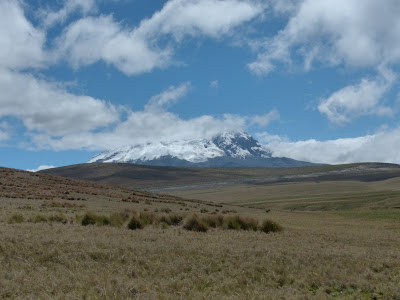The first couple days of our trip were spent at elevation - around 12,000 feet to 15,000 feet - mostly birding along roads and from the van. Fortunately, the windows of the van easily opened for some decent photos.
I've been trying to think of the story that will go with my Ecuador birding posts, and unfortunately for me (not necessarily for you) there is little narrative to go with these photos. Unfortunately for me only because I like the story and the writing of it. This should not imply that the trip was not great - because it was - only that the way it unfolded was straightforward and uncomplicated. There was no definitive
Super Bowl of birding day, so to speak, but there were several fine and favorite moments. I also made some observations about birding in a country with a well-established birding culture and infrastructure. Going forward most of my narrative will likely be comments on my observations.
In no particular order, the following photos were taken enroute to and in and around Antisana National Park.
Brown-backed Chat-Tyrant (Ochthoeca fumicolor)
Terrible photo of White-crested Elaenia (Elaenia albiceps)
Plain-colored Seedeater (
Catemenia inornata)
Great Thrush (Turdus fuscater) - seen and heard everyday
Black-winged Ground-Dove (Metriopelia melanoptera)
Above and below: female Ecuadorian Hillstar (Oreotrochilus chimborazo)
View of Ecuadorian Hillstar landscape.
Above and below: Stout-billed Cinclodes (
Cinclodes excelsior)
Andean Lapwing (Vanellus resplendens)
Carunculated Caracara (Phalcoboenus carunculatus)
Tawny Antpitta (Grallaria quitensis)
Chestnut-winged Cinclodes (Cinclodes albidiventris)
Many-striped Canastero (
Asthenes flammulata)
Horrible photo of Aplomado Falcon (
Falco femoralis) - but nice to see.
Antisana Volcano (above) looms over the Artisana NP and was seen from all of our high-elevation birding locations. Whenever I saw this volcano I couldn't resist yet another photo.
The photos above were taken around an elevation of 12,000 - 13,000 feet. The landscape was stark, wide-open and very beautiful. It was essentially a high-elevation desert. The birds seen here were so different than any seen elsewhere in Ecuador and even very different than any North American birds.
My next post will be from 15,000 feet where we went twice to look unsuccessfully for Rufous-bellied Seedsnipe (Attagis gayi latreillii) and Giant Conebill (Oreomanes fraseri).








































